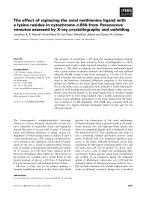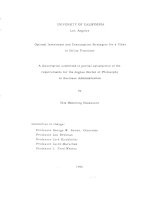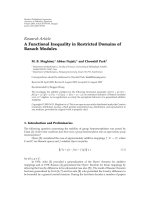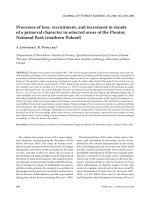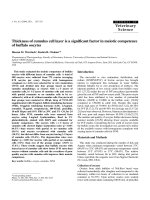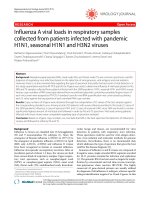A SURVEY INTO IN SERVICE ENGLISH TEACHERS IN HANOIS OPINIONS OF TEACHING ENGLISH AS AN INTERNATIONAL LANGUAGE THE COMPARISON AND CONTRAST OF NESTS AND NNESTS
Bạn đang xem bản rút gọn của tài liệu. Xem và tải ngay bản đầy đủ của tài liệu tại đây (1.32 MB, 122 trang )
VIETNAM NATIONAL UNIVERSITY, HANOI
UNIVERSITY OF LANGUAGES AND INTERNATIONAL STUDIES
FACULTY OF ENGLISH LANGUAGE TEACHER EDUCATION
GRADUATION PAPER
A SURVEY INTO
IN-SERVICE ENGLISH TEACHERS IN HANOI'S
OPINIONS OF TEACHING
ENGLISH AS AN INTERNATIONAL LANGUAGE:
THE COMPARISON AND CONTRAST
OF NESTS AND NNESTS
Supervisor: Dương Thu Mai (PhD.)
Student: Trịnh Mai Anh
Course: QH2017.F1
HÀ NỘI – 2021
ĐẠI HỌC QUỐC GIA HÀ NỘI
TRƯỜNG ĐẠI HỌC NGOẠI NGỮ
KHOA SƯ PHẠM TIẾNG ANH
KHÓA LUẬN TỐT NGHIỆP
KHẢO SÁT VỀ Ý KIẾN
CỦA GIÁO VIÊN TIẾNG ANH TẠI HÀ NỘI
VỀ VIỆC GIẢNG DẠY
TIẾNG ANH NHƯ MỘT NGÔN NGỮ QUỐC TẾ:
SO SÁNH GIỮA GIÁO VIÊN BẢN XỨ VÀ
GIÁO VIÊN VIỆT NAM
Giáo viên hướng dẫn: Dương Thu Mai (ThS.)
Sinh viên: Trịnh Mai Anh
Khóa: QH2017.F1
HÀ NỘI – 2021
1
I hereby state that I: Trinh Mai Anh, class QH2017.F1.E1.SPCLC, being a
candidate for the degree of Bachelor of Arts (programme) accept the requirements
of the College relating to the retention and use of Bachelor’s Graduation Paper
deposited in the library.
In terms of these conditions, I agree that the origin of my paper deposited in the
library should be accessible for the purposes of study and research, in accordance
with the normal conditions established by the librarian for the care, loan or
reproduction of the paper.
Hanoi, May 4th 2021
2
ACKNOWLEDGEMENTS
I could not finish this study without the kind support and help of many
individuals and I would like to express my appreciation to all of them.
First and foremost, I wish to extend my sincere gratitude towards my
supervisor, Mrs. Duong Thu Mai (PhD.) for her valuable sharing, feedback as well
as relentless support for me while I carry out this study. Without her assistance, I
could not have this research accomplished.
Moreover, I want to express my thanks to 150 in-service teachers who
partake in my study. They are immensely supportive, which is of great help for me
during the data collection process. Their participation in the questionnaire and
interview has played an important part in my study.
Last but not least, I feel thankful to my family members and all of my
friends for their precious advice as well as mental support, which helps forge me
ahead with my study regardless of setbacks.
i
ABSTRACT
English has reached an international status since there has been a significant
increase in the demographics of English-speaking communities and individuals
around the world (Sharifian, 2009). This trend has led to a paradigm shift in
teaching practices, shifting the attention to the concept of English as an
International Language (EIL) in ELT courses and materials as a way for
adaptation. To successfully implement EIL into English classrooms, it is of
importance to investigate the opinions of both NESTs and NNESTs on teaching
EIL given their differences in characteristics and strengths. Hence, this study is
carried out to compare the opinions of in-service native English-speaking teachers
(NESTs) and non-native English-speaking teachers (NNESTs) in Hanoi on
teaching EIL. The paper employed survey research design with the use of both
questionnaire and interview to shed light on the research problem. The study has
revealed the similarities in the opinions of both NESTs and NNESTs on different
EIL-related teaching contents and methodological considerations, particularly
students’ exposure to different sources of culture, the teaching of pragmatic
competence and vocabulary with high utility, the choice of materials and the
method of teaching grammar in contexts. Some significant differences in opinions
of the two groups were also identified concerning the teaching of varieties and
accents, acceptance of intelligible pronunciation, promotion of critical reading and
the allowance for students to vary in their fluency.
Keywords: English as an International Language, EIL, TEIL, NEST, NNEST
ii
TABLE OF CONTENT
ACKNOWLEDGEMENTS
i
ABSTRACT
ii
TABLE OF CONTENT
iii
CHAPTER 1. INTRODUCTION
1
1. Background information
1
2. Statement of the problem and rationale of the study
2
3. Aims and objectives
3
4. Scope of the study
4
5. Significance of the study
4
6. Outline of the study
5
CHAPTER 2: LITERATURE REVIEW
6
1. Teaching English and Teaching English as an International Language
6
2. The conceptualization of English as an International Language (EIL)
8
2.1. Definition of an international language
8
2.2. Definitions of EIL
8
3. What to teach in EIL
10
3.1. Standard English
11
3.2. Intelligibility and Fluency
12
3.3. English varieties
13
3.4. Interculturality
14
3.5. Teaching vocabulary
15
3.6. Teaching pronunciation
16
3.7. Teaching grammar
17
3.8. Pragmatic Competence
18
3.9. Teaching four major skills of EIL
18
4. EIL Teaching Approaches
20
4.1. General discussion
20
4.2. Lingua Franca Approach
22
4.3. Communicative Language Teaching Approach
23
4.4. Genre-based Approach
24
4.5. An appropriate methodology for EIL
25
4.6. Materials for teaching EIL
25
iii
5. NEST and NNEST dichotomy in teaching EIL
27
5.1. NES and NNES
27
5.2. NEST and NNEST
28
5.3. The importance of distinguishing between NEST and NNEST
29
5.4. NESTs and NNESTs’ opinions of EIL
29
6. Research gaps
31
CHAPTER 3: METHODOLOGY
32
1. Setting
32
2. Participants
32
3. Research Design
33
4. Research instrument
34
4.1. Questionnaire
34
4.2 Semi-structured Interview
38
5. Data collection
39
6. Data analysis
39
6.1. Quantitative data
39
6.2 Qualitative Data
40
7. Ethical issues
42
CHAPTER 4: FINDINGS AND DISCUSSION
43
1. Findings of the study
43
1.1. Responses to research question 1: What are NESTs and NNESTs’ opinions on the
contents of teaching English as an international language?
43
1.1.1. Exposing students to Standard English and other English varieties
43
1.1.2. Teaching students about cultures
45
1.1.3. Teaching EIL pronunciation
46
1.1.4. Teaching EIL vocabulary
47
1.1.5. Teaching EIL grammar
48
1.1.6. Teaching pragmatic competence
49
1.1.7. Teaching the content knowledge in four major English skills according to EIL 50
1.1.8. Conclusion
51
1.2. Response to research question 2: What are NESTs and NNESTs’ opinions on the
methodological considerations in teaching English as an international language?
53
1.2.1. Selecting suitable methods for teaching EIL
53
1.2.3. Teaching grammar
56
iv
1.2.4. Teaching four major skills according to EIL
56
1.2.5. Conclusion
58
1.3. Response to research question 3: What are the reasons for the teachers' opinions of
EIL teaching?
60
1.3.1. Reasons for the opinions on EIL teaching contents
60
1.3.1.1. Interview question 1: Reasons for the agreement and disagreement
with teaching English Varieties to students
60
1.3.1.2. Reasons for the agreement with teaching students about
interculturality
62
1.3.1.3. Reasons for the agreement with teaching EIL vocabulary
63
1.3.1.4. Reasons for agreement and disagreement with teaching EIL
pronunciation
63
1.3.1.5. Reasons for agreement with teaching EIL grammar
66
1.3.1.6. Reasons for agreement with teaching EIL pragmatic competence
66
1.3.1.7. Reasons for agreement with teaching four major skills with EIL
perspectives
67
1.3.2. Methodological considerations
68
1.3.2.1. Reasons for agreement and disagreement with selecting suitable
methods for teaching EIL
68
1.3.2.2. Reasons for agreement with EIL teaching materials
69
1.3.2.3. Reasons for agreement with EIL methods of teaching grammar
70
1.3.2.4. Reasons for agreement and disagreement with the methods of
teaching four major skills with EIL perspectives
71
1.3.3. Recurring themes
72
1.3.3.1. Theme 1: Global status of English
72
1.3.3.2. Theme 2: Ownership of English
73
1.3.3.3. Theme 3: Communication effectiveness
75
1.3.3.4. Theme 4: Learning effectiveness
76
1.3.3.5. Theme 5: Doubt on the teaching of EIL
77
2. Discussion of the findings
78
CHAPTER 5: CONCLUSION
81
1. Findings of the study
81
2. Implications
83
3. Limitations and suggestions for future research
85
APPENDICES
99
APPENDIX A
100
v
APPENDIX B
102
APPENDIX C
106
APPENDIX D
107
APPENDIX E
108
APPENDIX F
110
vi
LIST OF TABLES
Table 1: List of questionnaire items
Table 2: Teachers' opinions on the teaching of Standard English and English varieties
Table 3: Teachers' opinions on the teaching of cultures
Table 4: Teachers' opinions on the teaching of pronunciation
Table 5: Teachers' opinions on the teaching of vocabulary
Table 6: Teachers' opinions on the teaching of grammar
Table 7: Teachers' opinions on the teaching of pragmatic competence
Table 8: Teachers' opinions on the teaching of four major English skills
Table 9: Teachers' opinions on selecting suitable methods for teaching EIL
Table 10: Teachers' opinions on teaching materials
Table 11: Teachers' opinions on the teaching methods of grammar
Table 12: Teachers' opinions on the teaching methods of four major English skills
Table 13: Frequency of codes related to Theme 1: The global status of English
Table 14: Frequency of codes related to Theme 2: Ownership of English
Table 15: Frequency of codes related to Theme 3: Communication effectiveness
Table 16: Frequency of codes related to Theme 4: Learning effectiveness
Table 17: Frequency of codes related to Theme 5: Doubt on the teaching of EIL
vii
LIST OF FIGURES
Figure 1: An example of initial codes related to teachers' opinions of teaching EIL
Figure 2: An example of cross-cased refined coding of teachers’ reasons for their
opinions on teaching EIL
Figure 3: NESTs’ opinions on EIL-related teaching contents
Figure 4: NNESTs’ opinions on EIL-related teaching contents
Figure 5: NESTs' opinions on EIL-related methodological considerations
Figure 6: NNESTs' opinions on EIL-related methodological considerations
viii
ABBREVIATIONS
CLT
Communicative Language Teaching
EFL
English as a Foreign Language
EIL
English as an International Language
ELF
English as a Lingua Franca
ELT
English Language Teaching
L1
First language
L2
Second language
LFA
Lingua Franca Approach
MOET
Ministry of Education and Training
NES
Native English speaker
NEST
Native English-speaking teacher
NNES
Non-native English speaker
NNEST
Non-native English-speaking teacher
TEFL
Teaching English as a Foreign Language
TEIL
Teaching English as an International Language
TESL
Teaching English as a Second Language
WE
World Englishes
ix
CHAPTER 1. INTRODUCTION
1. Background information
English has gradually become the most widely used language all over the
world since the second half of the twentieth century (Yano, 2009). It is considered
that English is spoken by more second language (L2) than first language (L1) users
(Ayako, 2007). The significant growth in the number of L2 users has gradually
altered the central orientation of English language teaching (ELT) in many
countries. In such countries, learners acquire English as a foreign language for
communication with native English speakers (NESs). However, learners have
many more practical motivations for learning English. One of them is to acquire
the language for communication with other English speakers from different
linguistic backgrounds, including both NNESs and NESs (McKay, 2003).
In foreign language education for non-English speaking countries, the
global status of English has redirected the main goal of language pedagogy from
the development of native-speaker competence to comprehensibility and
intelligible use of more varieties of English. This trend has shifted attention to the
investigation of English as an international language (EIL). Considering EIL,
increased attention has been paid to the pedagogical practices of English language
teaching, and as Matsuda and Friedrich (2011) acknowledged, this entails the reexamination and modification of different aspects like teaching methodology,
instructional variety and model, curriculum and syllabus materials, language
testing, and TESOL teacher-education program. It is unquestionable that teachers
play an important part in the promotion of EIL and their opinions towards EIL
should be paid attention to improve the teaching practices in the Expanding-Circle
countries where English is often taught as the most popular foreign language.
1
2. Statement of the problem and rationale of the study
It is suggested that there exists a close link between teacher’s opinions and
teaching practices and thus teacher's opinions are considered an indicator for
teachers’ instructional decision-making in class (Ajzen and Madden, 1986;
Bayyurt and Sifakis, 2015; Pajares, 1992). Therefore, it is of utmost importance
that teachers' opinions are thoroughly investigated and comprehensively
understood to improve teaching practices.
In international contexts, many prolific scholars in the field namely
Alsagoff et al. (2012); Matsuda (2012); McKay (2002); Smith (1983) and Sharifian
(2009) have relentlessly promoted the importance of teaching English as “a
heterogeneous language with multiple grammars, vocabulary, accents, and
pragmatic discourse conventions” due to the changing status of English and the
paradigm shift in teaching practices. In Vietnamese context, EIL is recognized as
a part of the General School Education English Curriculum and according to the
Ministry of Education and Training in Vietnam (MOET) in 2018, students can
learn about the countries, people and cultures of different English-speaking
countries and other countries in the world, thereby becoming global citizens when
studying English. This once again highlights the need to facilitate the teaching and
learning of EIL.
The significance of teaching and learning EIL highlights the pivotal role
of the teachers in incorporating those elements into English classrooms and the
need to identify teachers’ opinions towards teaching EIL (Renandya & Farrell,
2011). The aforementioned role does not rest on not only NNESTs but NESTs as
well since it is perceived that NESTs and NNESTs have unique characteristics and
qualifications that are valuable to the teaching practices and can hardly be
compensated by the other party (Medgyes, 1992, 1999, & 2001). Hence, the
differences between NESTs and NNESTs should not be undermined but focused
on and put under consideration to improve teachers' effectiveness. This may bring
about many implications for the promotion of EIL. However, while there are many
2
studies considering the opinions of NNESTs, a few attempts have been made to
examine the opinions of native ones. Moreover, although the comparison between
NESTs and NNESTs regarding their opinions towards EIL may yield some
significant implications, there is a lack of related studies examining this gap
(Medgyes, 1992).
Due to the surge of EIL and the importance to examine teachers' opinions
towards EIL, the past two decades have witnessed a particular leap in research on
opinions of teachers towards EIL in international contexts, considering teaching
pronunciation, the promotion of different varieties of English, and the promotion
of different cultures (Sifakis and Sougari, 2005; Altun-Evci, 2010; Tajeddin, Atai
& Pashmforoosh, 2019; Elsheikh, 2015; Ubaidillah, 2019). However, available
studies have overlooked teachers' opinions on other EIL-related aspects like the
teaching of four major skills, grammar, intelligibility or pragmatic competence.
In conclusion, despite the importance of promoting EIL and studying
teachers' opinions of teaching EIL, teachers' opinions on the teaching of EIL have
not covered all EIL-related features. Besides, not many studies have been carried
out to examine NESTs' opinions or to put the opinions of NESTs and NNESTs
into consideration. To bridge the gaps, the researcher aimed at comparing inservice NESTs’ and NNESTs’ opinions towards teaching EIL. The study would
also examine teachers' reasons for their opinions for a better understanding of
NESTs and NNESTs' opinions. Hanoi is chosen as the setting for the study to take
place since recently, English has developed at an unprecedented pace in Hanoi
with an overwhelming number of English learners. Besides, it is one of the first
cities which allows NESTs to teach at schools alongside with NNESTs.
3. Aims and objectives
This research aims to identify in-service NESTs and NNESTs in Hanoi's
opinions considering teaching EIL and put them into comparison. Also, the study
3
seeks to determine the reasons for teachers' opinions to improve teaching practices
in light of EIL.
In brief, this study would address the following questions:
1.
What are NESTs and NNESTs’ opinions on the contents of teaching
English as an international language?
2.
What are NESTs and NNESTs’ opinions on the methodological
considerations in teaching English as an international language?
3.
What are the reasons for the teachers' opinions on teaching
English as an international language?
4. Scope of the study
The study focuses on identifying NESTs’ and NNESTs’ opinions on
teaching EIL, the similarities and differences in their opinions as well as the
reasons for their opinions. Other aspects including strengths, weaknesses of
NESTs and NNESTs as well as challenges they face during teaching EIL would
not be examined in this study. The literature for this study has been collected from
different sources concerning EIL-related issues like EIL conceptualizations,
teaching contents and methodologies as well as the dichotomy between NESTs
and NNESTs. Data will be collected from in-service NESTs and NNESTs who
work at different schools in Hanoi. The results may not be generalizable to the
larger population like in-service NESTs and NNESTs in Vietnam.
5. Significance of the study
According to MOET (2018), the teaching of EIL is incorporated into the
General School Education English Curriculum. In this curriculum, one of the main
objectives of teaching and learning concerning EIL is to help students understand
the countries, people and cultures of different English-speaking countries and other
countries in the world as well. Another objective is to make way for students to
become global citizens. Since teachers are the ones who implement these
4
objectives, it is of significance to explore their opinions towards EIL to ensure
teaching and learning effectiveness.
Besides, according to Medgyes (1992), NESTs and NNESTs have their
distinctive characteristics and the differences between the two groups should be
put into consideration to improve teachers' effectiveness. By comparing opinions
of NESTs and NNESTs, many significant implications can be yielded to improve
teaching practices. From the findings of this study, teachers can benefit from this
study as they can gain a comprehensive insight into the differences in EIL opinions
of NESTs and NNESTs, thereby considering those differences and working
together to come up with the most suitable measures when it comes to developing
and adjusting their teaching practices in class. Also, this research would contribute
to the pre-existing body of research concerning opinions of teachers towards EIL
and would act as references for further studies.
6. Outline of the study
This study is divided into the following chapters:
In chapter 1, the introduction of the study concerning the background
information of the study, namely the research problem, its aims, research questions
as well as the scope of the study is presented.
Chapter 2 focuses on the review of the literature. Ideas from different
bodies of literature are presented and synthesized to establish an ideology that
guides the research.
After reviewing the literature, the research methodology used for this
study is discussed in chapter 3.
In chapter 4, the collected data is analyzed and interpreted to reach an
answer to the research question.
Chapter 5 delves into the discussions of the study.
The last chapter, chapter 6, presents a summary of findings as well as
implications and limitations of this study.
5
CHAPTER 2: LITERATURE REVIEW
This chapter provides a comprehensive synthesis of existing bodies of
literature related to teaching EIL and the dichotomy of native English-speaking
teachers and non-native English-speaking teachers.
1. Teaching English and Teaching English as an International
Language
It has long been considered that the English language has gradually
become pluricentric, which is known as “World English" (Ubaidillah). This entails
the fact that countries are categorized into three groups namely Inner Circle
(including countries that use English as native language), Outer Circle (countries
using English as a second language) and Expanding Circle (countries using
English as a foreign language) (Kachru, 1985). This has proposed a new mindset
of using English and English varieties. Besides, recent decades have witnessed an
unrivaled increase in the number of English-speaking communities, English users
and English learners all over the world, with the number of non-native English
speakers outnumbering that of native English speakers (Ayako, 2007).
Facing such new contexts, traditional ELT has been claimed to fail to
recognize the international status of English. Firstly, this is because traditional
ELT is norm-bound, which considers acquiring native-like competence is the
ultimate goal of learning English (Jenkins, 2003; McKay, 2003) and also because
any other model apart from the native norms is “an error” (Kachru, 1992b;
Jenkins, 2003). In other words, the English taught in many countries is mostly
American or British English. Nevertheless, Kasper (1997) argued that it is
impossible to reach the level of competence of native speakers, and even native
speakers are not even considered a homogeneous group (McKay, 2003; Seidlhofer,
2005). Furthermore, many scholars claimed that the monolingual approach
considering English as a native language model is “utopian, unrealistic, and
constraining in relation to EIL” (Alptekin, 2002). Firstly, this model is utopian in
6
a sense that what is referred to as native speakership is a linguistic myth (Paikeday,
1985; Rajagopalan, 1999) and it reflects a monolithic opinion of the language and
culture of the native speakers, by focusing mainly on the popular ways of thinking
and behaving. Secondly, this native speaker model is unrealistic because it did not
manage to depict the lingua franca status of English with the number of non-native
speakers exceeding natives ones. It also restricts EIL since it links the notion of
authenticity to the social environments of the native speaker. This makes the
autonomy of not only teachers but also learners suffers because the language which
is authentic for native speakers may not be suitable for non-native speakers
(Widdowson, 1998). Hence, with the recent international status of English,
traditional ELT was no longer an appropriate method for the teaching and learning
of English.
Considering the implications of the global status of English, there is a need
for ELT to take appropriate pedagogies and choice of materials that are beneficial
for learners in both localized and international contexts into consideration. As a
result of dissatisfaction with the native speakers' model, scholars have begun to
propose a change in paradigm and an “appropriate model” in ELT. Many scholars
advocated the concept of English as an international language (EIL) (Matsuda,
2003; Jenkins, 2003; McKay, 2003), arguing that EIL is suitable for the teaching
and learning of English as English is no longer the possession of a nation or a group
of people and is not any specific English varieties in the Inner Circle like British
English or American English. It is an international language that acts as a
communication vehicle in different regions of a country and communities across
international and cultural boundaries. This entails the fact that other English
varieties in the Outer or Expanding circles should not be overlooked (Kachru,
1992; Jenkins, 2003; McKay, 2003; Widdowson, 1994).
Thus, this section has reviewed an apparent change in the status of English
that leads to the need to reconsider ELT and the emergence of EIL. It also helps to
shed light on the importance of EIL and the need to further examine this field.
7
Hence, in the next part, different conceptualizations of EIL proposed by many
scholars are taken into consideration.
2. The conceptualization of English as an International Language
(EIL)
2.1. Definition of an international language
To thoroughly understand the concept of EIL, it is crucial to have a grasp
of what an international language is. Smith (1976) was deemed to be one of the
first to conceptualize an international language by circumscribing the scope of an
international language. He proposed that an international language is used by
people from different countries to communicate with others. However, the use of
an international language is not only limited to an international sense so McKay
(2002) has broadened its scope. Hence, an international language can be viewed
as a language that guarantees broader communication amongst individuals not only
from different countries but also in a single country as well. Based on this scope,
English can be viewed as an international language since English is spread to all
the continents and used by speakers to communicate with people of other countries
(Rao, 2019). Besides, English is also used in many Outer Circle countries as means
of communication between different regions. To exemplify, due to the complicated
geographical and societal status of the Philippines, English makes communication
possible between groups of people there who do not share a native language or
dialect (Vu, 2012).
2.2. Definitions of EIL
There is a large body of literature on the conceptualization of EIL (McKay
& Matsuda, 2012; McKay & Brown, 2016; Sharifian, 2009). Some scholars tried
to conceptualize EIL by stating what is not EIL. Firstly, EIL is not a variety so
using the term “EIL” interchangeably with the term “International English” is
problematic. The term “International English” is different from EIL in a sense
8
that the use of an adjective going with “English” tends to refer to a specific variety
like British English or Indian English. However, EIL in fact does not represent a
particular variety and mistaking EIL for a variety poses numerous problems to the
understanding of EIL. To commence with, viewing EIL as a linguistic variety
“fails to represent the diverse nature of EIL communication”, which focuses on
specific contexts and situations. Besides, a variety could not be appropriate in all
possible EIL contexts. Another problem is that constructing one such “supernational variety” would “create another layer of English language hierarchy and
generate greater inequity among speakers of different Englishes” (Friedrich &
Matsuda, 2010).
Besides, EIL is normally used interchangeably with World Englishes
(WE) or English as a Lingua Franca (ELF), but it is necessary to differentiate their
focus. WE focuses on “the study of English as an investigation of the linguistic
features” that speakers typically use (McKay, 2018), which implies that the focus
of WE is the content (features of different varieties) and not interaction. In terms
of ELF, this term has been conceptualized as “interactions between members of
two or more different linguacultures in English, for none of whom English is the
mother tongue” (House, 1999), which means the interactions between secondlanguage speakers from different linguistic and cultural backgrounds. In this way,
it can be understood that all English as first language speakers would be taken out
of the focus of ELF. EFL deals with both content (features of interaction between
second-language speakers of English) and interaction. Compared to WE and ELF,
EIL has a broader coverage and what sets EIL apart from WE and ELF is that the
use of EIL requires a set of specific principles, considering the need to refer to
local contexts in any pedagogical decisions regarding standards and curriculum,
the use of L1 in classrooms, the development of strategic intercultural competence
should exist in all EIL classrooms and the cultural neutrality of EIL.
Regarding the conceptualization of EIL, it is conceptualized in different
ways by several scholars: “paradigms or perspectives” (McKay 2002; Sharifian
9
2009) or “the functions or uses of English in international contexts” (Matsuda &
Friedrich, 2010). As for “the functions or uses of English in international
contexts”, EIL could be applicable to situations that “cross and go beyond any
national border” (Matsuda & Friedrich, 2010). Moreover, EIL is also understood
as a new “paradigm for thinking, research and practice” (Sharifian, 2009). EIL is
claimed to have brought about “a paradigm shift in TESOL and SLA” (Marlina,
2014; Sharifian, 2009) as it represents a “linguistic or epistemological lens" for
researchers, scholars and educators to reexamine the ways of conceptualizing
English, re-assess approaches in TESOL, and reconsider pedagogical strategies for
English language teaching (Marlina, 2014).
Although the term EIL has got a grip on different aspects of language
studies, this study takes pedagogy as the fundamental nature of EIL into
consideration. In this way, the concept EIL implies that it is basically Teaching
English as an International Language - a “socially sensitive English pedagogy”
(McKay, 2012), similar to the link between the term English as a Second Language
and Teaching English as a Second Language.
To conclude, this section has synthesized different conceptualizations of
EIL, which aids the understanding of this concept. To further elaborate this concept
to inform the research instrument in this study, many aspects of EIL teaching
contents which have been popularly discussed in the literature are analyzed in the
next part.
3. What to teach in EIL
For a long time, one major purpose of studying and teaching English has
been considered to be preparing learners to interact with native speakers (Jenkins,
2003). As a result, learners were traditionally taught native norms, linguistically
and culturally. However, as EIL has risen to global popularity, the goal of learning
English has changed from communicating with native speakers to communicating
10
with native as well as non-native speakers (Suzuki, 2010). This shift leads to
changes in what teachers need to incorporate into the lessons.
3.1. Standard English
The issue of standards is of importance in the study of EIL as many people
are concerned that with the spread of English, some changes in English will make
it different to the extent that it no longer serves the major purpose of an
international language. There are different efforts in conceptualizing what is meant
by Standard English. According to the Longman Dictionary of Applied Linguistics
(Richards, Platt, and Weber, 1985) associated Standard English with the written
form of language. It conceptualizes Standard English as “the variety of a language
that has the highest status in a community or nation and is usually based on the
speech and writing of educated speakers of the language”. They also highlighted
the extent to which Standard English is used, which is in the news media and
literature, in dictionaries and grammars as well as taught in schools and taught to
non-native speakers when they learn the language as a foreign language.
The conceptualization of Standard English in Webster’s Third Dictionary
(Quirk, 1990) added to the notions given in The Longman Dictionary of Applied
Linguistics that Standard English is uniform, used in both “informal and formal
speech and writing of the educated” as well as acceptable widely wherever English
is used and understood.
This study would use the conceptualization based on the manifestations of
both dictionaries mentioned earlier, in which Standard English can be understood
as the language variety that is widely accepted wherever it is used and understood.
It possesses the highest status in any community or nation and is based on the
formal and informal speech and writing of educated speakers of the language.
Moreover, Standard English is commonly used in the news media, literature,
dictionaries, grammars as well as used as the language of instruction and taught to
non-native speakers when they acquire English as a foreign language.
11
There has long been heated debate revolving around Standard English.
Supporters like Quirk (1985) argued if standards are not upheld, the intelligibility
among English speakers will decrease. On the other hand, others like Kachru
(1985) deemed that the loss of intelligibility will be unlikely to happen as many
English speakers in Outer Circle country learn this language in the school settings
where standards are promoted.
However, regarding EIL teaching contents, it is supported that unifying
norms are still needed in an educational context (Widdowson, 1994). Indeed, due
to the spread of English, many varieties have developed, so to serve the purpose
of wider communication in EIL, it is necessary to maintain standards to ensure
communicative effectiveness. Hence, Standard would be considered as EIL
teaching content in this study. This contributes to the formation of the
questionnaire on teachers' opinions regarding teaching contents. It should also be
noted that Standard English in Vietnam is considered British-English and
American English (Tien, 2008).
3.2. Intelligibility and Fluency
As for intelligibility, what is meant by this term is complex, which often
revolves around intelligibility (recognizing the expression), comprehensibility
(knowing the meaning of the expression) and interpretability (knowing what the
expression signifies in a particular socio-cultural context). In this study, the term
“intelligibility” covers all three types of the meaning given above, in which
intelligibility can be understood as “the urgent need to establish discourse that can
be mutually understood in a specific communicative framework” (McKay, 2003).
Intelligibility plays an important role in EIL acquisition and it brings a sensitivity
to the communication context (Levis, 2005).
When it comes to intelligibility, two principles, namely nativeness
principle and intelligibility principle, are often taken into consideration.
Nativeness principle “holds that it is both possible and desirable to achieve nativelike pronunciation in a foreign language”. However, with the importance of
12
intelligibility of EIL speakers, McKay and Brown (2015) suggested that
intelligibility principle, which “holds that learners simply need to be
understandable” (Levis, 2005), is a better choice in EIL contexts.
Besides intelligibility, fluency is an aspect that receives significant
attention from scholars. There are many ways to conceptualize fluency. Lennon
(1990, p. 388) proposed two definitions for this term namely the broad definition
and the narrow definition. The broad definition referred to fluency “as a cover
term for oral proficiency”, as in “the highest point on a scale that measures spoken
command of a foreign language” (p. 389). As for the narrow definition of fluency,
it is “one, presumably isolatable, component of oral proficiency”. This sense is
found particularly in procedures for grading oral examinations. Richards and
Schmidt (2002) described fluency as “the features which give speech the qualities
of being natural and normal, including native-like use of pausing, rhythm,
intonation, stress, rate of speaking, and use of interjections and interruptions'' (p.
204). The similarity of these definitions is that they focus on oral language only.
As for Richards and Schmidt's definition, it includes different aspects but would
not work well in EIL contexts as the definition has included words like “nativelike” or “normal”. Although desirable, it is challenging for students to achieve
native-like fluency. McKay and Brown (2016) have adjusted the definition as the
characteristic that helps speech to be natural and understandable in a specific EIL
community, including “contextually appropriate use of intonation, word stress,
utterance stress, transition, assimilation, ellipsis, pauses, appropriate speech rate,
fillers, and so forth” to be appropriate for EIL settings. In other words, when it
comes to accuracy and fluency, intelligibility should be focused on rather than
native-like norms. This is also the definition applied in this study.
3.3. English varieties
In literature, a language variety is generally defined in a broad sense. It is
considered that the notion of a variety of language is relatively expansive, covering
different aspects namely the standard language (for educational and public
13


